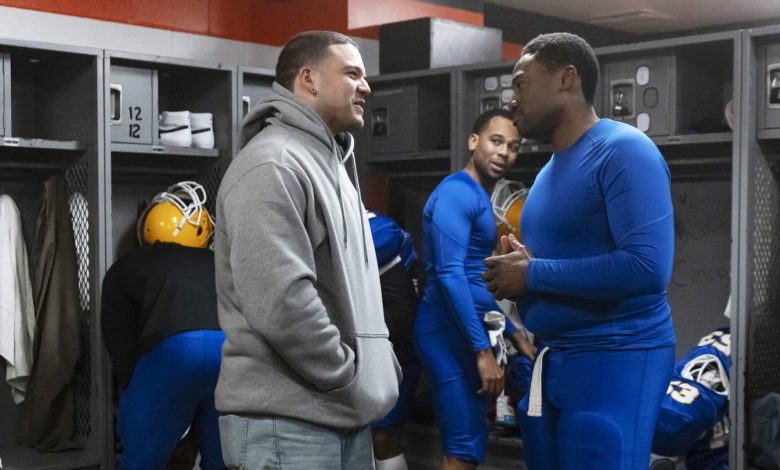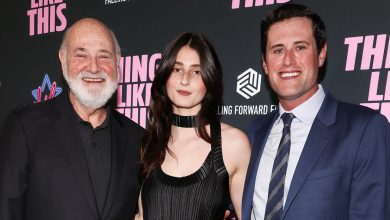‘American Sports Story: Aaron Hernandez’ Director Steven Canals and Key Cast on Why Odin Lloyd’s Death Hit So Hard

[This story contains spoilers from the eighth episode of American Sports Story: Aaron Hernandez, “Odin.”]
Filming Odin Lloyd’s murder in episode eight of the FX series American Sports Story: Aaron Hernandez was particularly challenging for Josh Rivera who plays Aaron Hernandez, the one-time New England Patriots NFL star who was later convicted for the murder of Lloyd, and who died of an apparent suicide in prison. Taking the life of Lloyd, the boyfriend of Shaneah Jenkins, the sister of Hernandez’s fiancée Shayana, was personally devastating to the actor. Not only had Hernandez and Lloyd hung out a few times and, by most definitions, were friends, they were also potential in-laws.
“To have your life taken, something about that settled with me in a different way,” says Rivera of reenacting the heinous murder. “When you’re talking about true crime, there’s this barrier we put up that kind of separates ourselves from the reality of that, and something about shooting that scene really settled in me the gravity of what that was.”
J. Alex Brinson, who plays Lloyd, worked hard to ensure that the gravity of Lloyd losing his life hit hard. “The main thrust that I held onto in building, developing this character and this role, was the basic human desire and need to live and to want to live a full life to reach your full potential.”
Though born in Saint Croix in the U.S. Virgin Islands, Lloyd grew up mostly in a rough area of Dorchester in Boston. To help capture who Lloyd was, Brinson says, “I watched interviews with his sister, with [Shaneah] his mom and I tried to allow those things to infuse [my portrayal of] how he moved.”
Like Hernandez, Lloyd played football, but not for the NFL. Instead, he was with the Boston Bandits in a semi-pro league with dreams of one day being in the NFL. So it’s only natural he would look up to Hernandez who had achieved that dream. But the “Odin” episode doesn’t begin with football. Before Lloyd hits the screen, his Caribbean heritage is honored with a food shot before a woman emerges as she prepares a family meal. Because “Hey, Ma” are Lloyd’s first words, it’s clear from the very beginning that he is loved and means something to someone.
Affirming Lloyd’s humanity was of paramount importance to director Steven Canals, who is best known for Pose, which he conceived and later developed with American Sports Story boss Ryan Murphy, especially as a man of color himself. “Aaron, as you know, was part Latin, and the folks that he murdered were all men of color. And so I think there’s this added element to it as well, when we think about race and class and how that impacts this,” says Canals.
Prior to working with American Sports Story, Canals had already listened to the Gladiator podcast, the series’ source material from The Boston Globe and Wondery. He also read the 2018 book The Truth About Aaron: My Journey To Understand My Brother by Jonathan Hernandez, better known as D.J. Hernandez. In many ways, Pose, which dealt with a wide spectrum of issues, including HIV and death, helped Canals clearly communicate that to Brinson and, in turn, the audience. “The conversations we were having on set while we were producing [Pose] was always in an effort to make sure [the actors] were okay, because we were asking them to go to very scary, emotional places. So in that way, [Pose] prepared me to work on American Sports Story in that, again, I was having to have really important, really intense conversations with the cast.
“From the very beginning, from the very first day that we met, I pulled him aside before we ever shot a single scene, and I said, ‘what’s really important to me is that you and I find a way to honor Odin’s life. I don’t want this story, and certainly I don’t want this particular episode, to feel exploitative. I want to make sure that we acknowledge that this was a real man, a real Black man who existed, who was murdered.’
“And so any scene that I filmed with J. Alexander [sic] in it, we always took a moment to just step aside, one-on-one, just to have a quick conversation, and I always made sure to check in with him [and ask] ‘how are you feeling? How’s your heart?’ and create space for him to articulate how he was feeling. Because what we were asking him to do was really intense and, in many ways, was really triggering and really scary.”
The same was true for Rivera. “I remember having conversations with Josh [saying], ‘It’s going to be really tough to lead up to these moments where Aaron kills Odin.’”
Brinson, who is married to Lindsay Mendez who plays Aaron’s trusted older cousin Tanya Singleton, worked hard to ensure his knowing Odin’s fate as an actor wouldn’t disrupt what was on screen. Instead, he kept Odin’s mindset of he and Aaron being friends, So, in his mind, says Brinson as Odin, “This was the beginning of something great for me, and we were going to build from a family standpoint, from being brothers and in laws, and then Aaron just went crazy. I felt that there was something not right with him, but I didn’t think he was going to take my life.” He also played mind tricks on himself and he believes going through an emotionally dark period personally also helped him capture Odin’s humanity.
Emotions aside, production challenges loomed large. “As a filmmaker, that was arguably the hardest day of filming I’ve ever had. It was really tough,” says Canals. “I believe we shot that in February, like the beginning of February, in New Jersey. So it’s freezing and the episode is supposed to be taking place in Massachusetts, in the summer.”
Shooting in the freezing cold wasn’t the main obstacle, however. “The night before we were supposed to film, there was a huge rainstorm,” he shares. “We get in and everything is just soup. It’s muddy because it rained, and we had to keep moving. There was a lot of work that had to be done. We had to take about three hours out of our shoot time to create something that the actors could walk on that wasn’t mud, so they wouldn’t just drop into the ground.”
But then there were other challenges. “I think we were filming that at probably, like eight, nine o’clock at night, but at this point, the car got stuck in the mud. On three separate occasions, we had to have a tow truck come out to pull the car [out] because it kept getting stuck. The actors only had a limited number of costume changes, but there was mud everywhere, which obviously impacted how I shot some of those moments. At a certain point, it was like, I’m just going to have to shoot from the waist up, because their sneakers and the bottom of their pants were just completely muddy. So, it was tough.”
Through it all, Canals says both Brinson and Rivera, who share a genuine affection for each other, stayed completely present. “It was painful,” says Brinson. “Josh had to do the ending of life, and I had to want to live.”
For Canals, “Dirty Pain,” episode seven, was key to making “Odin,” episode eight, feel so real. And that starts with the script, he insists. “They were really strong and did a great job of capturing and highlighting Aaron’s paranoia. It isn’t by chance that, in the height of his drug use becoming more frequent and more intense, that then you see this paranoia get really heightened. It’s a lot of Sherrod [Hernandez’s one-time street friend and arguably earlier enabler whom he shot at close range but found out later didn’t kill]. You have Sherrod making threats [via text]. And you just had this confluence of a lot of different pressures all stacking up for Aaron at the same time, in addition to trying to be a good partner to Shayana and to be a father to his daughter. And he’s also still a huge NFL star. Now he’s got this guy who’s saying, ‘I’m going to expose you for who you really are.’ And what does one person do when all those pressures exist? In the seventh episode, he, in his mind, gets to escape to California because he has to have this surgery, and, ultimately, all he does is find himself continuing to spiral.”
In keeping with that, the last shot of episode seven is of Hernandez standing in front of his personal arsenal in a secret apartment his fiancée has no knowledge of, presumably prepared for battle.
“The truth is that Aaron’s never really speaking for himself because he’s no longer alive. And so for me, I was really trying to get deeper into his psyche, but also to understand how the people who knew him best related to him, who was the person that they knew. Because I think who we are behind closed doors is going to be different from who we are front-facing and publicly,” says Canals. “I understood him to be really complicated and to be someone who was tortured. But is that accurate? I don’t know. I don’t have the ability to talk to him, and so for me, I just was trying to get an understanding of all the versions of Aaron that I understood to exist.”
Episode eight really sets the stage for the series, not just its final two episodes. “This is the moment that changes everything,” says Canals. “And it’s interesting because it’s not that Aaron hadn’t already committed crimes and hadn’t done things. Aside from the fact that it’s Odin’s death that ultimately precipitated his getting arrested and being incarcerated, I think the difference in Odin’s death versus any of the other crimes he had committed before was that connection, right? I think that, for Aaron and for the audience, it was easier to dismiss perhaps some of what happened, because he didn’t have as deep a connection.
“Because J. Alexander [sic] is such a phenomenal actor, such a beautiful human being, you fall in love with Odin,” says Canals. “So it’s heartbreaking, because it’s like, ‘Why? Why would [Aaron] do this?’”
***
American Sports Story: Aaron Hernandez releases new episodes Tuesdays at 10 p.m. on FX and Hulu.
Source: Hollywoodreporter
Related Posts
- Roundball Rocked: With NBA Return Looming, NBC Purges Scripted Roster
- SoundCloud Says It “Has Never Used Artist Content to Train AI Models” After Backlash on Terms of Service Change
- Fox News’ Camryn Kinsey Is “Doing Well” After Fainting on Live TV
- Kerry Washington and Jahleel Kamera in 'Shadow Force.'
Courtesy of Lionsgate
…
- This Alternative Artist Landed a Top-20 Chart Debut With an Album Made Almost Entirely on His Phone





